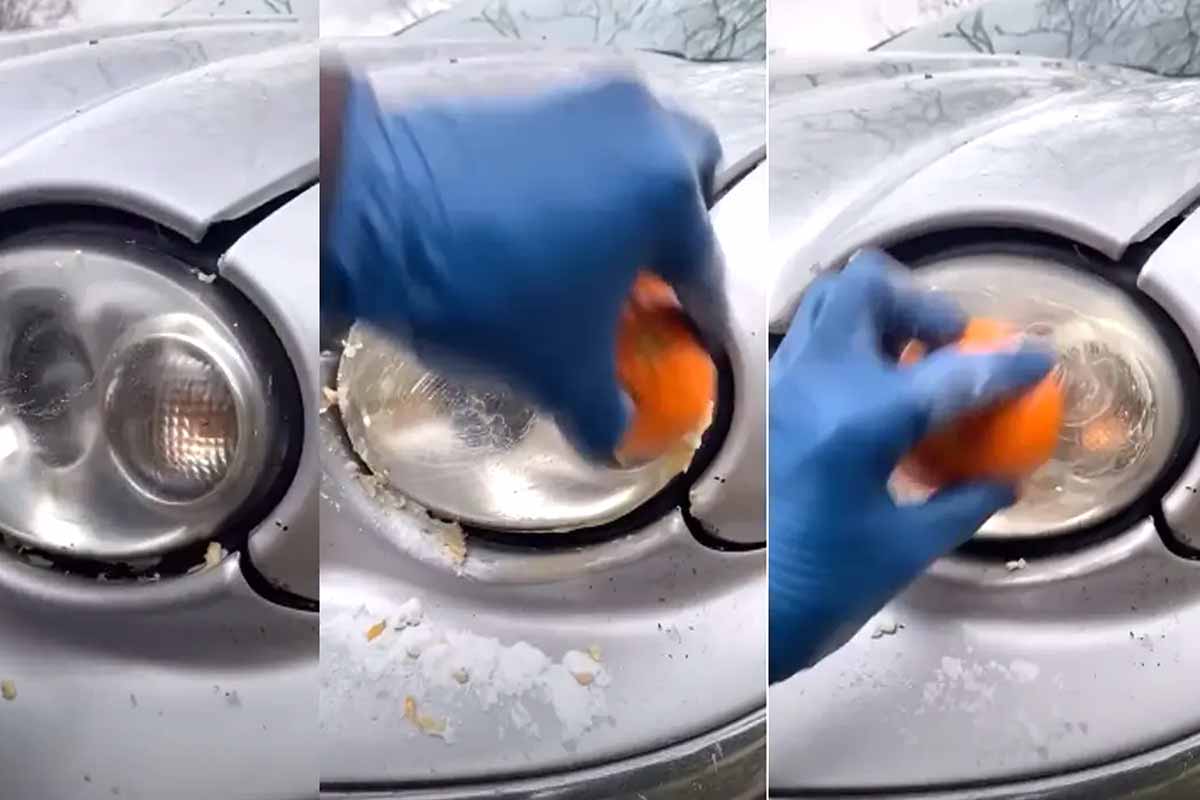Cloudy lenses dull a car’s look and cut nighttime visibility, yet a pantry fix restores shine fast. Lifestyle creator Bee (@simplybiancaalexa) shows a one-minute method that revives headlights without pricey kits, harsh sprays, or a trip to the shop. The trick uses simple chemistry, so the plastic clears while grime lifts. Because the process is gentle, drivers keep beam pattern crisp and the lens safe. Results appear quickly, and the routine stays budget-friendly and eco-minded.
Why fog builds up and how a citrus scrub counters it
Moisture and dust get trapped on polycarbonate covers. So, lenses haze and turn yellow. Road salt, bug residue, and sun exposure add a rough film that scatters light. Night driving then feels tense because glare grows as beams diffuse. Drivers often reach for strong solvents, yet plastic can haze worse.
Bee’s kitchen method addresses the buildup while staying kind to the lens. Oxidation and sticky grime respond to a mild acid paired with a gentle base. Because the reaction loosens deposits, residue wipes away without scratching. A soft cloth finishes the job, so clarity returns and edges stay smooth.
Quick steps matter since most people clean cars in a rush. Halve an orange, dust it with baking soda, and squeeze to wet the surface. Use circular motions across the cover, and keep pressure light. Wipe the lens dry, then enjoy brighter headlights within seconds.
How to do it in under a minute for crystal-clear headlights
Slice a fresh orange, then sprinkle baking soda over the cut side. The juice activates the powder, so tiny bubbles start working at once. Because the mix foams lightly, grime lifts from pits and corners. A microfiber cloth helps collect loosened film without leaving lint.
Move in small circles across the lens to keep the action even. Work from top to bottom, and refresh the orange when the fizz slows. The goal is contact time, not force, so avoid pressing hard. Rinse or wipe with clean water. Then, dry the edges and trim.
Expect an instant visual shift since haze masks a lot of light. Bee says, “This is crazy, it works,” and viewers echoed the surprise. Comments ranged from “I’m shook omg” to simple “wow” reactions. Because results arrive fast, people actually repeat the routine and maintain headlights.
Practical gains, sensible risks, and easy best practices to follow
A mild citrus-soda polish cuts film while avoiding strong solvents that sting skin. Ammonium sulfate and other additives in many cleaners wash into waterways, so wildlife suffers. Drivers want shine, yet they also want fewer toxins at home. This simple method gives both, plus less plastic waste.
Costs shrink as the routine replaces bottled sprays and disposable towels. Over ten years, households can save about $900 while avoiding 200 pounds of toxic chemicals. Even small choices add up because repeat cleaning multiplies the impact. People keep cars tidy, and the driveway stays safer for kids.
Some rules prevent harm, so follow them closely every time. Never mix bleach with vinegar, as the reaction creates a toxic gas. Keep citrus and soda away from paint for long periods to avoid marks. Tape around edges if needed, then clean the lens and protect headlights.
Durability notes and care choices that extend the clear look for headlights
The glow fades over months because UV light re-oxidizes plastic, so maintenance helps. A quick sealant after cleaning blocks sun damage, while the lens stays smooth. People often work in shade because heat dries residue too fast. Consistent routines keep the beam sharp and forward-focused at night.
Bottled products promise a showroom shine, yet many bring hidden tradeoffs. Plastic containers and paper towels pile up in bins and gutters. Volunteers often pick that litter, so choosing reusables matters. Cotton rags and refillable spray bottles cut waste while keeping the driveway clean.
Source notes encourage safe choices because home cupboards can hide hazards. The citrus-soda combo stays gentle, while harsh blends cause trouble. Label cleaners, and store them apart so accidents never start. Bee’s demo reminded viewers that simple chemistry clears the lens and brightens headlights.
When to go beyond DIY, plus tips for safer, longer-lasting results
Deep pitting or cracks will not polish away, so inspect the lens first. Sanding kits can restore clarity, yet they demand patience and steady hands. Professional work might cost more, yet it adds a UV coat. Replacement makes sense when the plastic is brittle or broken.
Light output matters as much as clarity, so check aim after cleaning. Misaligned beams blind oncoming drivers and reduce your own range. Follow your manual to adjust height and cutoff, then road-test at dusk. The car will feel calmer because the path ahead looks steady.
Community reactions suggest people value simple wins they can see. Bee’s viewers posted flushed-face emojis and short, excited notes. That social proof pushes busy drivers to finally try the routine. A small habit, repeated, keeps lenses clear and makes headlights look new.
A small weekly ritual that boosts safety and cuts chemical use
Clear lenses restore confidence because the road finally looks sharp again. People spend less since fruit and baking soda cost pennies and work fast. Waste drops as bottles and towels stay on shelves instead of bins. Try the citrus scrub once, then let brighter headlights become your norm.
